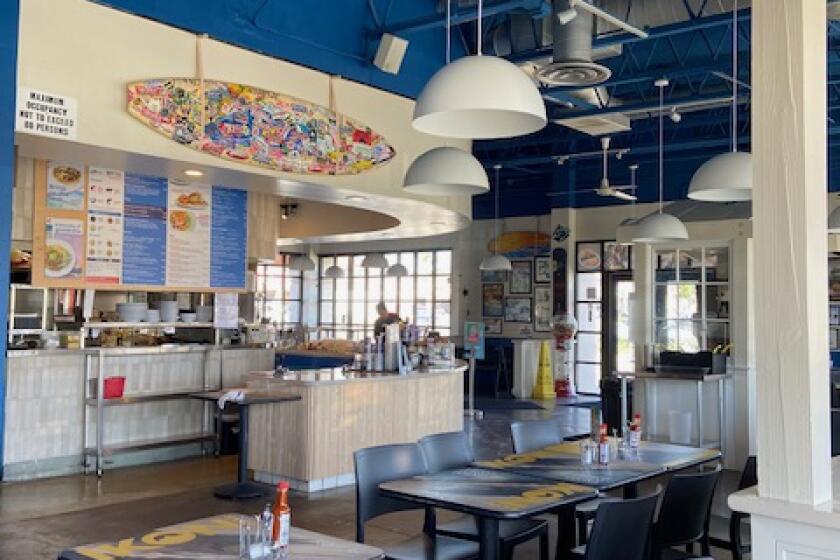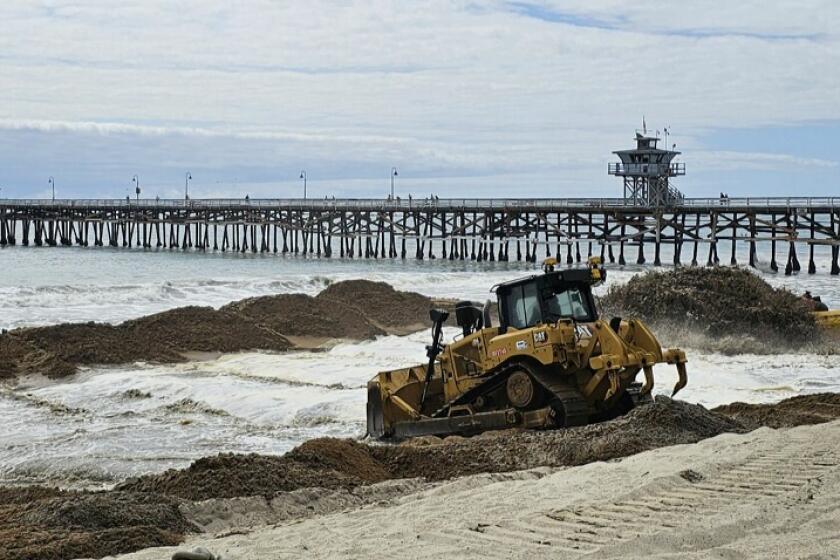Commentary: Reader Report: Mideast trip unearths story about camel-riding soldiers who patrolled what became O.C.
The heat was stupefying. It had reached 112 degrees when I visited Wadi Rum, a spectacular mountain range of rose-colored sandstone and a UNESCO World Heritage site north of the Gulf of Aqaba and the Red Sea in southern Jordan.
But when I discovered that the regional headquarters of the Royal Jordanian Desert Forces’ Camel Corps lay nearby, I ventured there as well, driving to its compound on the outskirts of Wadi Rum Village, a dusty hamlet of about 350 residents, modest houses, two schools, several small markets and a mechanic’s garage, which advertised itself by a pickup truck that sat atop the building’s roof.
When I arrived unannounced at my destination, I was greeted warmly by Capt. Tarek Zyad, the commanding officer, and his men, all clad in the Jordanian army’s dark green uniform and black beret. Members of the local Zalabia Bedouin tribe, they laughed good-naturedly when I unwittingly stepped into a pool of camel droppings, which filled my shoes and rose up to my ankles.
The troopers were preparing to saddle up their nine camels, resting in the shade of an adjoining pasture, and venture into the desert, which is inaccessible to four-wheel-drive vehicles, in search of criminals and smugglers of tobacco, electronic equipment, stolen cars and trucks, illicit drugs and illegal weapons. Rescuing lost hikers and infiltrators from neighboring Saudi Arabia, Israel, the Palestinian territories, Syria and Iraq also are among their responsibilities.
Wadi Rum, which translates into “valley” or “dry river” in Arabic and Hebrew, was a prime filming site of David Lean’s 1962 motion picture “Lawrence of Arabia,” which starred Peter O’Toole, who told a magazine interviewer that the camel he was assigned during the production “was impossible to ride ... I found my bottom bleeding from bouncing up and down on the snorting great dragon.” The motion picture, which won seven Oscars, celebrated the exploits of British archaeologist and Royal Army Col. T.E. Lawrence, who bivouacked at Wadi Rum with his Bedouin troops while conducting combat operations against the pro-German Ottoman Turks during World War I.
My visit with the Jordanian Camel Corps during a recent three-week trip to the Middle East immediately jogged my recollection of a little-known chapter in Orange County history: The U.S. Army also had camels, which during the Civil War served as pack animals attached to cavalry units that patrolled Southern California and northern areas of present-day O.C. while on the lookout for Confederate sympathizers who advocated turning California into an independent, pro-Confederate republic. (California had been admitted to the Union on Sept. 9, 1850, and Orange County broke off from Los Angeles County on March 11, 1889, to become a separate county.)
The Army’s experiment with camels began in the mid-1850s, when it was realized that the new Army forts and camps in the vast territories of the West and Southwest, which had become part of the U.S. following the 1846-48 U.S.-Mexican War, were not satisfactorily supplied by the slow-moving oxcarts and horse-drawn wagons traditionally used by the military, according to Michael Deagon, historian at Fort Tejon State Historic Park, which lies off I-5 south of Bakersfield and is the site of the original Fort Tejon (1854-1864). The fort also had been sent several of the camels.
So the three-masted, 547-ton Navy supply ship appropriately named the USS Supply was dispatched on two successive voyages to bring back 88 one-hump Dromedary and two-hump Bactrian camels, thought to be swifter and more agile than the Army’s horses, oxen and mules. Upon their arrival to the United States, they were sent to military installations in the West and Southwest.
One of these posts was Camp Drum, also known as Drum Barracks, which was located in Wilmington near the Port of Los Angeles, where an estimated 3,000 soldiers were stationed during the Civil War to monitor the pro-secessionists, many of whom had been born in the South and now called Southern California their home, Deagon said.
Hundreds of them, including several from present-day Orange County, flew Confederate flags from their front porches and joined militia units, such as the Los Angeles Rifles, headed by the Los Angeles County sheriff, who led his armed members on marches and drills across the county. Similar groups were formed in San Bernardino, Riverside and other communities east and north of Los Angeles, he added.
Army cavalry units, bolstered by Camp Drum’s 30-plus pack camels, traveled south to Long Beach harbor and the present-day Orange County port cities of Seal Beach and Huntington Beach in search of secessionists. Defense of the coast was paramount to the soldiers and the crew of the tiny U.S. Navy warship Camanche, the only USN ship in the area during the Civil War. Rumors flew across the state that the heavily armed, 250-foot Confederate Navy ship Shenandoah and an accompanying armada of commerce raiders or pirate ships flying the Confederate flag was headed for San Francisco, where they would attempt to capture the city with the help of local secessionists.
Then, according to the rumors, the Shenandoah would sail southward and capture Los Angeles for the Confederacy. Hysteria reigned, and coast watchers patrolled the Southern California beaches as they did during the two World Wars.
And there was yet another fear: That Confederates might try to hijack heavily laden Union transport ships traveling along the coast carrying gold and silver from the mines of Northern California and Nevada’s Comstock Lode bound for the East to be used to help finance the Northern war effort.
Further rumors circulated that California secessionists also were planning to seize Catalina Island, and troops from Camp Drum were rushed there and established Camp Santa Catalina. Today, the fort’s still-standing barracks serve as the clubhouse of the Isthmus Yacht Club.
All of the rumors relating to Confederate seizures across California proved to be just that, rumors. The Confederate fleet never materialized. No California ports and Catalina Island were invaded. No Civil War battles occurred in California. Secessionists evaporated following impressive Union victories in the North, Camp Drum and the dozen or so other forts in California were downsized at the war’s end and eventually closed. One of Camp Drum’s 19 buildings, the officers quarters, still stands and today is a public museum.
As for the camels: They had not gotten along with the Army’s mules and horses, they fought among themselves and proved to be unsuitable to the West’s rough and rocky roads. The Army, relieved to get rid of the surly and cantankerous animals, sold most of them to civilian transporters. Some ran off into the deserts of California, Arizona and Nevada and others were sold to circuses and zoos, stated historian Deagon.
“Topsy,” believed to be the last of them, died at the Los Angeles Zoo in April of 1934 at the unusually old age of 81, thus ending the Army’s “camel experiment,” which played a unique and little-known role in Southern California Civil War history.
David C. Henley, a Newport Beach resident, is a contributor to Times Community News.
All the latest on Orange County from Orange County.
Get our free TimesOC newsletter.
You may occasionally receive promotional content from the Daily Pilot.



